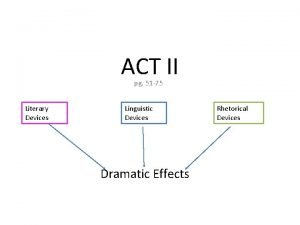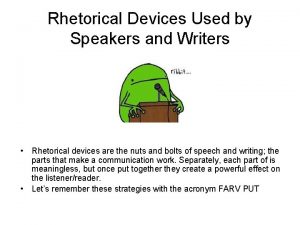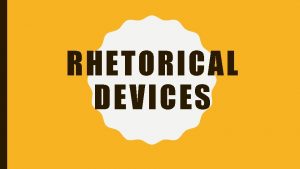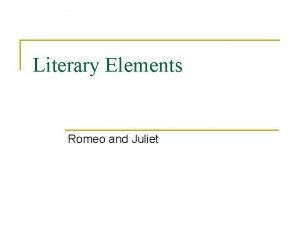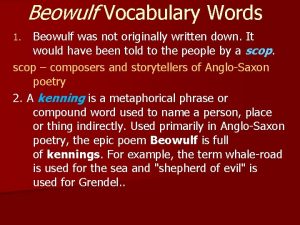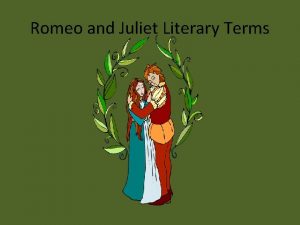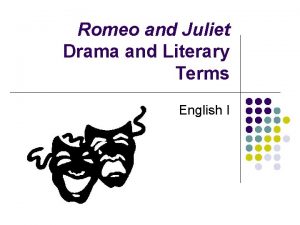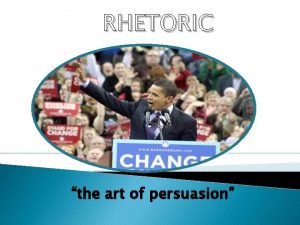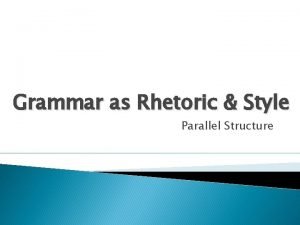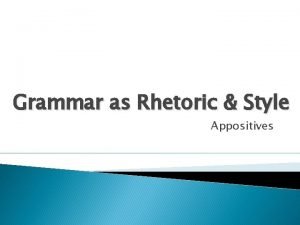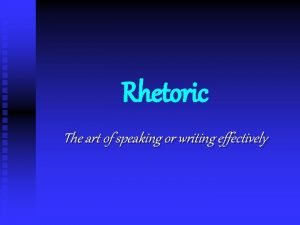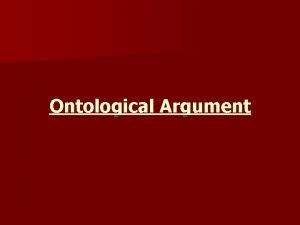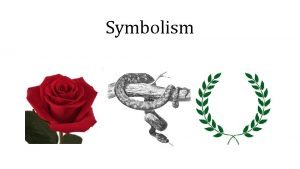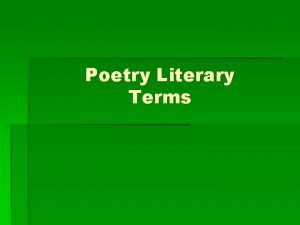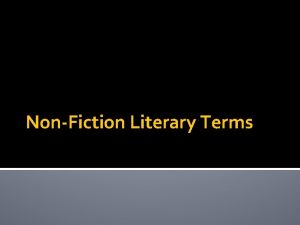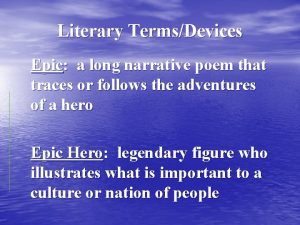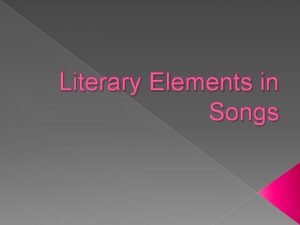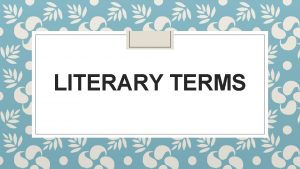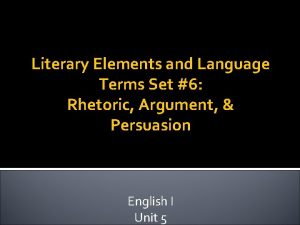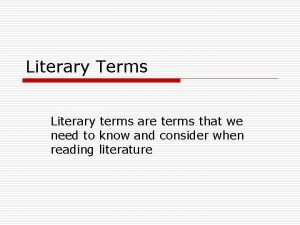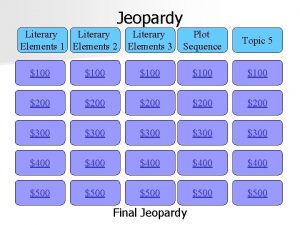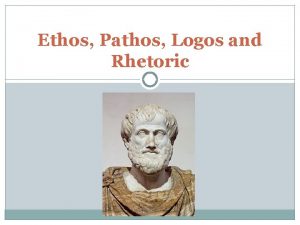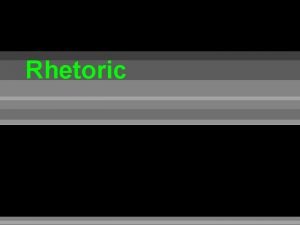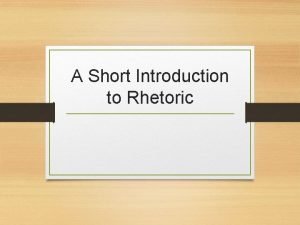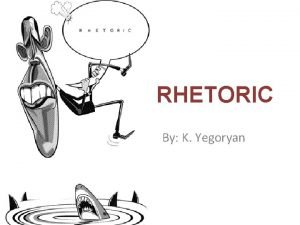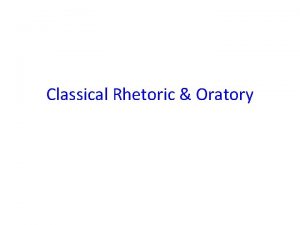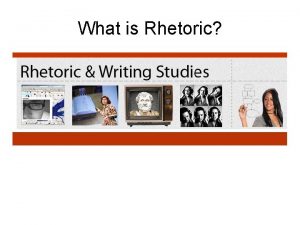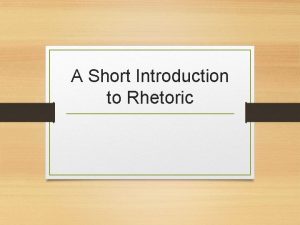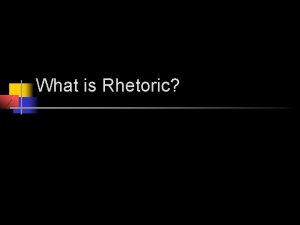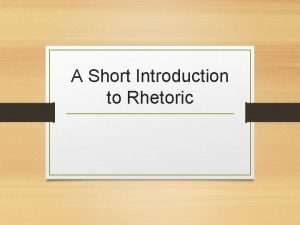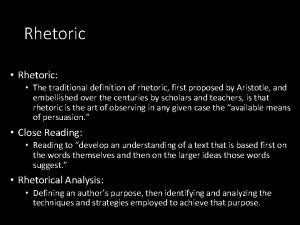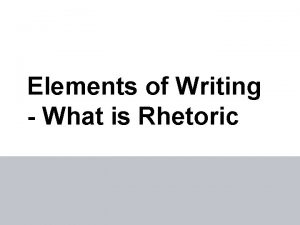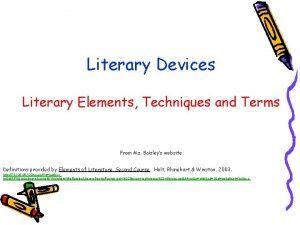LITERARY ELEMENTS LANGUAGE TERMS Argument and Rhetoric Argument























- Slides: 23

LITERARY ELEMENTS & LANGUAGE TERMS Argument and Rhetoric

Argument, Persuasion, And Rhetoric: The art of using language purposefully. When trying to argue and persuade someone of something, we think carefully of how we might best achieve our goal, and we pick particular words because of their effect.

Style of an Argument Example: “Yesterday, December 7 th, 1941 -- a date which will live in infamy -- the United States of America was suddenly and deliberately attacked by naval and air forces of the Empire of Japan. ” – President Franklin Delano Roosevelt

Style of an Argument Persuasion: To cause a person to believe or do something by reasoning with him or her. Example: “Friends, Romans, countrymen, lend me your ears; / I come to bury Caesar, not to praise him; / The evil that men do lives after them, / The good is oft interred with their bones, / So let it be with Caesar. . . “

Style of an Argument: Expresses a position on an issue and supports that position with reasons and evidence. An argument often takes into account other points of view, anticipating and answers objects that opponents to the issue might raise. Counterargument: An argument made to oppose another argument. A good argument anticipates opposing viewpoints and provides counterarguments to refute (disprove) or answer them.

Fact or Opinion Fact: A statement that can be verified as correct or incorrect Opinion: A personal feeling or judgment about something. Typically, we persuade people to agree with our opinions by using facts to support those opinions. Beware of words such as “everyone, ” “all” “believe, ” “worst, ” “seems, ” “best, ” “think, ” and “better, ” all of which indicate that you are dealing with an opinion and not a fact.

Fact or Opinion: You decide. 1. 2. 3. 4. 5. 6. 7. 8. Everyone loves chocolate. New York is the largest city in the United States. I believe that the beach is the best place to vacation. I think the main character in the movie is hilarious. April is one of the Spring months. You are the best dancer in the whole school. Brian Cushing was just voted NFL Defensive Rookie of the Year. Dogs are superior to cats.

Constructing Arguments Issues: Points at which individuals disagree. The large questions underlying people's opinions. Positions: The opinion formed by an individual on an issue. The way the individual ANSWERS the question posed by the issue. Based on our positions, we make… Assertions: A statement offered as truth, which is actually an opinion. An assertion is the foundation of every argument.

Successful arguments must… Have or develop several solid, logically-based reasons to support your assertion. “Logically” implies that they must be reasons that can be supported with evidence. Target your reasons for the specific audience you are trying to convince. You must know who you are trying to persuade, otherwise you have a moot point. Provide the counter arguments with appropriate rebuttals in order to weaken the opposition’s argument. Use persuasive appeals and rhetorical devices appropriately and effectively.

The Three Persuasive Appeals

Logos An appeal to logic or rational reasoning. If you can explain real-life cause and effect and if/then situations, and make reasonable comparisons using facts and figures that can be verified, then you are using logos. Example: “Dad, you should let me drive to school today, because I have to go straight from school to a doctor’s appointment at 3: 00, and I will be late to my appointment if I walk to school rather than drive. ”

Ethos An appeal based on the character of the speaker. This appeal is based on whether or not the audience perceives the speaker as someone who is morally competent, trustworthy, and knowledgeable on the subject about which s/he is speaking. Example: “Dad, you know I have always been a responsible son and I never taken advantage of the privilege to drive, and I know that you would not want me to miss my doctor’s appointment, as the school requires I have a physical before playing football; therefore, you should let me drive to school so that I may fulfill my obligation. ”

Pathos An appeal to emotions or feelings including fear, humor, romance, compassion, etc. This includes the use of loaded language. Example: “Dad, I feel really sick today… and you know I love school and would never want to miss any of my classes… so you should let me drive to school today so I can go to the doctor right after school before this gets any worse; and in my weakened condition it would be hard to walk all the way there. ”

Rhetorical Structures And Devices Analogy: A comparison made between two things to show they are alike in some respects. All similes and metaphors are analogies. Extended Metaphor: A figure of speech that compares two essentially unlike things at length and in several ways. Example: “All the world’s a stage, And all the men and women are merely players…Last scene of all, that ends this strange eventful history…” – William Shakespeare

Rhetorical Structures And Devices Paradox: An apparently contradictory statement that actually reveals some truth. Examples: “Everyone is completely unique, just like everyone else. ” “Some day you will be old enough to start reading fairy tales again. " -The Lion, the Witch, and the Wardrobe Each new power won by man is a power over man as well. Each advance leaves him weaker as well as stronger. -C. S. Lewis Exception Paradox: "If there is an exception to every rule, then every rule must have at least one exception, the exception to this one being that it has no exception; ” Petronius’ Paradox: "Practice moderation in all things. Including moderation. "

Rhetorical Structures And Devices Oxymoron: A concise paradox that brings together two contradictory terms. Examples: “jumbo shrimp, ” “act naturally, ” “found missing, ” “genuine imitation, ” “good grief”

Rhetorical Structures And Devices Parallelism: Repetition of words, phrases, or sentences that have the same grammatical structure or that state a similar idea. Example: “It was the best of times, it was the worst of times, it was the age of wisdom, it was the age of foolishness, It was the epoch of belief, it was the epoch of incredulity, it was the season of Light, it was the season of Darkness…” Anaphora: The same expression (word or words) is repeated at the beginning of two or more successive clauses or sentences. Example: “I have been one acquainted with the night. I have outwalked the farthest city light. ” Epistrophe: Ending a series of lines, phrases, clauses, or sentences with the same word or words. Example: What lies behind us and what lies before us are tiny compared to what lies within us. " —Emerson

Rhetorical Structures And Devices Anecdote: Very brief account of an incident. Example: In her essay, “Homeless” Anna Quindlen uses an anecdote about a homeless woman to introduce a discussion of homelessness. Truism: A statement, the truth of which is obvious or well-known. Proverb: A saying that briefly and memorably expresses some recognized wisdom or truth about life Examples: “Still waters run deep. ” “A penny saved is a penny earned. ” “A friend in need is a friend indeed. ” “Time and tide wait for no man. ”

Rhetorical Structures And Devices Sarcasm: A kind of particularly cutting irony. Generally, sarcasm is the taunting use of praise to mean its opposite – that is, to insult someone or something. Example: Saying, “Nice shoes” in a way that makes it clear that you believe the shoes to be hideous. Satire: A literary technique in which ideas, customs, behaviors, or institutions are ridiculed for the purpose of improving society. It often involves the use of irony and exaggeration to force readers to see something in a critical light. Examples: “The Daily Show, ” “The Colbert Report” & “The Onion”

Logical Fallacies Bandwagon: an appeal to either identify or not identify with a group. Suggests that a person should believe or do something because “everyone else” does. Example: “If you’re a true American you’ll place a flag in front of your house. ” Stereotyping: A dangerous type of overgeneralization. Stereotypes are broad statements about people on the basis of their gender, ethnicity, race, political affiliation, religious affiliation, etc. Example: “The only thing members of that political group care about is taxing people. ” Circular Reasoning: Supporting a statement by simply repeating it in different words. Example: “Teenagers should avoid fad diets, because it is important for adolescents to stay away from popular weight-loss plans. ”

Logical Fallacies Either/Or Fallacy: A statement that suggests there are only two choices available in a situation that really offers more than two options. Example: “Either students should be allowed to leave school to have lunch at nearby restaurants, or they should be allowed to choose the cafeteria menu. ” Oversimplification: An explanation of a complex situation or problem as if it were much simpler than it is. Example: “Making the team depends on whether or not the coach likes you. ” Evading the Issue: Refuting an objection with arguments and evidence that do not address its central point. Example: “Yes, I broke my campaign promise not to raise taxes, but these higher taxes have led to an increase in police patrols and paved highways. ”

Logical Fallacies Ad Hominem: Also called “name-calling” or “attacking the person. ” An attempt to discredit an idea by attacking the person or group associated with it. Candidates often engage in this during political campaigns. Example: “My opponent is not smart enough to be mayor. ” Slippery Slope: A fallacy in which a course of action is objected to on the grounds that once taken, it will lead to additional actions until some undesirable consequence results. Example: “If we loosen immigration policies, the nation will be overrun and the economy will collapse. ”

Argument Structure
 75 literary terms elements and devices
75 literary terms elements and devices Tricolon sentence examples
Tricolon sentence examples Rhetoric literary devices
Rhetoric literary devices Literary devices
Literary devices Polynomial classification
Polynomial classification Combining like terms definition
Combining like terms definition Literary elements of romeo and juliet
Literary elements of romeo and juliet Examples of alliteration in romeo and juliet
Examples of alliteration in romeo and juliet Beowulf vocabulary and literary terms
Beowulf vocabulary and literary terms Figurative language examples romeo and juliet
Figurative language examples romeo and juliet A long uninterrupted speech
A long uninterrupted speech Rhetoric: the art of persuasive writing and public speaking
Rhetoric: the art of persuasive writing and public speaking Rhetoric parallelism
Rhetoric parallelism Grammar as rhetoric and style exercise 1 answers
Grammar as rhetoric and style exercise 1 answers The art of speaking and writing
The art of speaking and writing The ontological argument
The ontological argument Literary devices jeopardy
Literary devices jeopardy Symbol literary term
Symbol literary term Symbolism literary definition
Symbolism literary definition Poetry terms hyperbole
Poetry terms hyperbole Nonfiction literary terms
Nonfiction literary terms Literary term epic
Literary term epic Ap lit literary terms
Ap lit literary terms A comparison not using like or as
A comparison not using like or as
